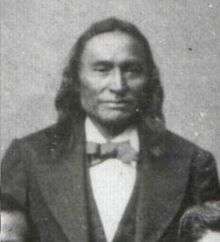Wanata

Wa-na-ta (Dakota: Wánataŋ which translates as One who charges, or Charger) was a chief of the Yanktonai, a tribe of the Dakota. Chief Wa-na-ta, also known as Wanata and Wanataan I, was born around 1795. The Yanktonai were located near the St. Peter River, which is today known as the Minnesota River, in present day Minnesota. The Yanktonai were said to have a population between five and six thousand individuals with 1,300 warriors. Wanata was a very influential chief, as evidenced by his ability to lead his tribes' 1,300 warriors into battle.
At age 18, Wanata was accustomed to the ways of war and fought under his father Red Thunder (then the chief of the Yanktonai) against the Americans in the War of 1812. Wanata was recruited by British Colonel Robert Dickson whom convinced him to join him in battle at Fort Sandusky. During this battle, Wanata charged Fort Sandusky and was wounded, but earned himself the nickname “Charger.”
After the war, Wanata sided with the Americans and even helped influence trade on the Missouri River. He was murdered by his own tribesmen who were upset with his leadership in 1848.
In 1882, A. R. Fulton, author of "The Red Men of Iowa" reported: "One of the greatest men of the Sioux nation ever known to the whites was Wa-na-ta, a chief of the Yankton branch of that nation, who flourished during the first half of the present century. He distinguished himself as a warrior at the age of eighteen, when he fought under his father against the Americans. He was one of a band of savages collected from the Northwest by Colonel Dixon during the War of 1812, and was wounded in an engagement at Sandusky. After that war he professed friendship toward the United States. He devoted himself to the business of uniting and more thoroughly organizing the several tribes or bands of his nation, and in maintaining both aggressive and defensive warfare against the neighboring tribes, and especially the Chippewas and Iowas. From the position of chief of the Yanktons he rose to be recognized as the grand chief of the Sioux nation.[1]
Chief Wanataan II

Historians of the Midwest region all know of the famous Yanktonai Chief Waneta (sic) (1795-1840) and his son of the same name Wanata II, (Waanatan II) (1828-1897). Their names are in almost every history book dealing with Minnesota and the two Dakota States. Waanatan II was born in 1828 on the Elm River (Pecan Wakpa) north of what is now Aberdeen, South Dakota. When his father was assassinated in 1840, the Pabaksa (Cut Head) band of Yanktonai split into three groups, each led by a son. Waanatan II moved to Lake Traverse (Bde Hdakinyan = Cross-Wise Lake) associating himself with his mother's people, the Sisitunwan Dakota. Waanatan II forbade Little Crow from crossing his lands to escape Federal troops during the Minnesota Uprising of the Dakota War of 1862. Suffering many hardships during the war which followed, he finally surrendered his band some five years later and resided on the Spirit Lake Reservation (Miniwakan Oyanke) in north central North Dakota.
In 1885, Chief Wanata (Waanatan II) became friends Major Israel McCreight and visited his office regularly to smoke tobacco.[2] At the time, the twenty-one-year-old McCreight seeking adventure took the Northern Pacific Railway to its farthest point west, Devils Lake, North Dakota, Dakota Territory, and met with Indians trading buffalo bones at Fort Totten, North Dakota, to be sold as fertilizer in the lucrative St. Louis market. McCreight was impressed with the chief’s dignity and bearing. “One day he signed that he wished a private interview, when he drew from his blanket a package which he exhibited as something he held more precious than any other treasure. It was carefully wrapped in old newspaper, and after it had been divested of the strings and unrolled to be read, it proved to be the parchment or treaty with Government officials, his own name inscribed as head or Grand Chief. Having thus established his old-day tribal office, he carefully refolded the document, wrapped it in the faded news sheet and returned it to the inner folds of his blanket, then nimbly squatted on the office floor, filled his pipe and enjoyed his usual half-hour smoke.”[3] Wa-na-ta’s smoking pipe was his most precious possession. “A titled English ranch-owner who knew of his importance in history offered any price that the old chief would name for the pipe and pouch, but the chief disdained to listen to any offer of money. But when I squatted beside him on the floor, where he was puffing meditatively on his long red-stone pipe, to tell him of leaving next week for a trip west, he arose instantly, untied his belt, laid both pouch and pipe across his left hand and extended it to me as a present and token to be preserved after he had passed to the long sleep.” McCreight forever remembered the kindness and generosity of Wa-na-ta.[4]
Chief Wanataan II died in 1897 and is buried in the St. Michael Cemetery, St. Michael, ND.[5]
References
- ↑ http://www.dlncoalition.org/dln_nation/chief_wanata.htm
- ↑ McCreight mistakenly believed Wa-na-ta (Wanata) to be Waanatan I. McCreight notes, “In a report of a government expedition, which visited his tribe in 1845 Wanata, was referred to as the head chief who then had more power than any Indian in the North American continent.” Go West Young Man, P.23.
- ↑ M.I. McCreight, "Firewater and Forked Tongues: A Sioux Chief Interprets U.S. History", p.95.
- ↑ M.I. McCreight, “Go West Young Man”, 1941, at p.24, Nupp. Printing Co., Sykesville, PA See Louis Garcia, “Waanatan’s Tobacco Bag”, Whispering Wind, Issue #270, Vol. 39, #2 (2010).
- ↑ See Louis Garcia, “Waanatan’s Tobacco Bag”, Whispering Wind, Issue #270, Vol. 39, #2 (2010) at http://www.thefreelibrary.com/Waanatan%27s+pipe+and+tobacco+bag.-a0229897146
Sources
- "Chief Wanata", URL accessed 07/23/06
- Johnson, Michael, and Jonathan Smith. Tribes of the Sioux Nation. Oxford: Osprey, 2000.